Plastic gas pipes - a new word in gasification
In our mighty state, it is traditionally customary to equip gas systems with metal pipes. But time goes on and in all industries more and more metal is being replaced by high-quality polymers. Our people are also starting to wonder whether plastic pipes can be used for gas, in which systems it is allowed and how safe it is.
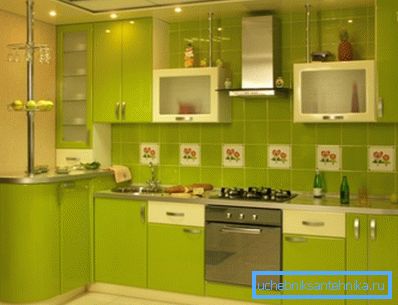
We will not reveal much secrecy if we say that in the west metal is used only for transporting liquefied gas under high pressure. For the construction of urban highways and gasification of houses gas plastic pipes are installed. At the moment, according to GOSTs of our country, the installation of plastic in the municipal gas sector is also allowed.
How are gas pipelines classified
There will be gas through plastic pipes or only the installation of metal is allowed, it directly depends on the operating pressure in the system. The higher it is, the more stringent safety requirements are imposed on the material. After all, whatever gas is transported, all these objects are always classified as high danger.
Constructions that supply gas to our homes are divided into 4 main categories.
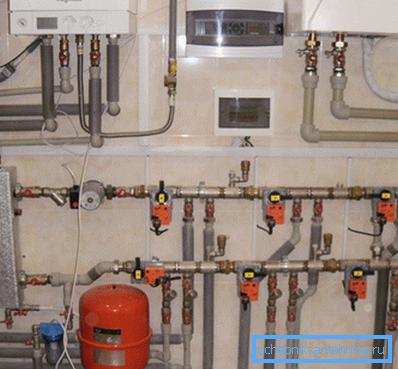
- Systems of the first category are designed for a working pressure in the range of 0.6 - 1.2 MPa for structures transporting natural gas or gas-air mixtures. For transportation of LPG, the pressure standard is 1.6 MPa. Such structures are mounted exclusively from steel, both external and underground method.
- The second category regulates the supply of mixtures under pressure in the range of 0.3 - 0.6 MPa. These structures transport the mixtures between the city’s intermediate gas distribution stations.
- Medium pressure constructions are designed for 0.005 - 0.3 MPa. These are pipelines that deliver the mixture from the intermediate gas distributor to several high-rise buildings or streets in the private sector.
- Directly wiring for apartments or houses is performed by low pressure systems of less than 0.005 MPa.
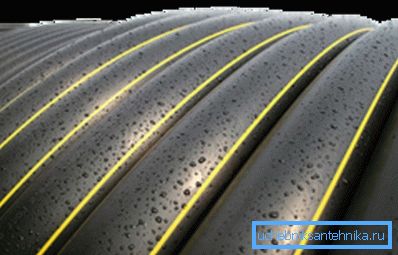
Whether it is possible to use plastic pipes for gas or to stay on the metal also depends largely on the seismic activity of the area, which soils in this area and the presence of stray currents.
Where and how are polymers mounted
Although the market for polymer products is quite wide, not every plastic is suitable for use in gas facilities. In addition, plastic is significantly inferior in strength to metal, in connection with this special requirements are imposed on the installation of such structures (also read the article Steel water and gas pipes - their characteristics and features).
What polymers are allowed
- Polyethylene gas pipes are currently leading among polymers in the gas supply market, the price is affordable. Thick-walled polyethylene pipes for gas can be used in lines 3, and in some cases even 2 categories.
Polyethylene wiring around the house is also quite acceptable. This material does not react with the transported mixture and is not afraid of external exposure to chemically active substances.
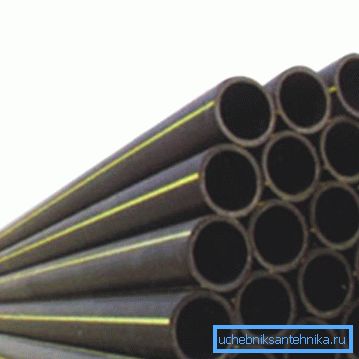
- But polyethylene pipes for gas have several significant limitations. In particular, these constructions are not recommended to be used if there is a probability of lowering the temperature, below -25? С. In addition, this material is afraid of exposure to ultraviolet rays, so these pipes cannot be mounted on the sun.
Important: all gas pipes PND and other polymers, in comparison with metal, are distinguished by low weight and low mechanical stability. In this connection, the laying of these lines outside the buildings is permitted exclusively by the underground method.
- Metal-plastic is also allowed for installation on gas lines. Due to the multi-layer structure, it is more durable and durable compared to polyethylene, but its mechanical strength also leaves much to be desired. Therefore, it should also be laid in a hidden way.
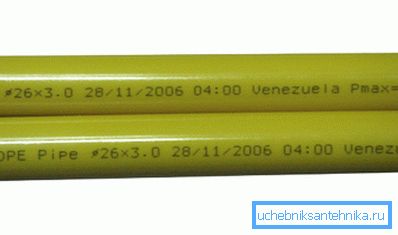
Important: PVC PVC products are not recommended for use in gas facilities, as this material is able to react with some mixtures and release toxic chloroethylene.
- Polypropylene gas pipes for laying internal wiring in the house fit almost perfectly. The price of this material is more, but the technical characteristics are disproportionately higher than those of competitors.
Their strength is quite enough for laying in an open way around the apartment, they have the highest resistance to any chemically active substances. Polypropylene pipes for gas are not afraid of sunlight and are easy to fit.
Installation Tips
As mentioned earlier, HDPE pipes for gas (HDPE - low pressure polyethylene) are afraid of the sun, have low weight, high elasticity and temperature limitations. This causes hidden underground or inside the walls installation of structures.

And under the ground such lines are laid, only with insulation, they can not be placed in concrete boxes or galleries equipped, as in case of leakage, the probability of an explosion is high. In the case of gaskets in the walls, the coefficient of thermal expansion to which this material is exposed should be taken into account. The lines are equipped with soft insulation.
When installing, consider the fact that the smaller the design will be various connecting nodes or transitions, the more stable will be the pressure, therefore, significantly reduced energy consumption for transportation. HDPE systems can be connected by means of crimp fittings or butt-weld.
Crimp fittings are only suitable for transporting fluids, polyethylene gas pipes can only be joined by butt welding, they are marked in yellow.

Polypropylene pipes for gas supply are joined in the traditional way, using a special soldering iron. In accordance with the diameter of the products, nozzles of the appropriate size are selected and installed on the soldering iron.
After that, the pipe and fitting are put on both sides of these nozzles. Within a few seconds, the heating takes place, then the details are connected to the stop. Do not forget that after docking, the connection must be kept in a static static position for 5 - 7 seconds.
The system can be put into operation after 20 minutes. If the layout is done in an open way along the wall, then it should be fixed with an interval of at least 50 cm.

Metal-plastic lines are mounted only in a closed way. This is very convenient if, for example, a renovation is done. Durable, elastic material has a low coefficient of thermal expansion, so it can be safely bricked into the walls.
With the same pipes it is convenient to equip lines between nearby buildings in private construction. Throw a branch out of the house in the summer kitchen, it is possible with the help of metal pipes.
As for the connection of metal-plastic lines, the instruction allows installation only press fittings. The pipe, in this case, is inserted all the way into the crimping sleeve and crimped using a special tool. All such connecting systems are not designed for dismantling, they are mounted permanently.

Important: all work on the installation of gas lines should be carried out exclusively by specialists who have special permission. Plus, the route scheme must be registered in advance and approved by the relevant authorities. With your own hands, you can only connect a flexible gas hose from the pipe to the gas stove.
The video in this article shows some points related to plastic pipes.
Conclusion
Although household gas distribution distributors refer to low-pressure systems, gas plastic pipes should be carefully selected for it, and it is better to entrust this to specialists. After all, gas is not a joke, and a mistake here can be expensive (see also the article “Water-gas pipe and its features”).
